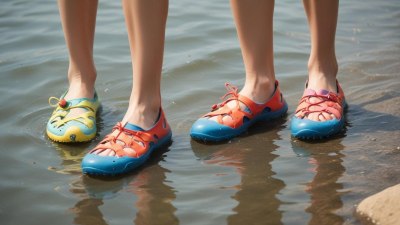Why Water Shoes Are Either a Life-Saver or the Worst Fashion Choice You’ve Ever Made
Explore the dual nature of water shoes - essential protection or fashion faux pas? Discover their pros and cons.

This image was created with the assistance of Freepik
Water shoes are one of those divisive pieces of outdoor gear that seem to either be a life-saver or just plain unfortunate when it comes to style. For anyone who enjoys water sports, beach outings, or hiking near lakes and rivers, the question of whether to wear water shoes is a common dilemma. They promise safety and comfort but risk rendering the wearer a target for jest or ridicule among the fashion-conscious. In this article, we'll delve into the pros and cons of water shoes, exploring their functionality, styling issues, and the overall impact they have on outdoor activities.
First and foremost, let's discuss the practical benefits of wearing water shoes. For outdoor enthusiasts, especially those engaging in activities like kayaking, paddleboarding, or hiking rocky shorelines, water shoes serve as a protective barrier between one's feet and potential hazards lurking beneath the surface. Sharp rocks, shells, or even glass can easily ruin an otherwise perfect day on the water. Water shoes are designed to be lightweight and durable, providing the essential protection needed to navigate these environments safely.
Moreover, water shoes often feature quick-drying materials. Traditional footwear can absorb water and become soggy, weighing you down and causing discomfort. Water shoes, on the other hand, are crafted from synthetic materials that dry quickly, ensuring that your feet remain comfortable. This is especially important during hot summer days spent on the beach or near bodies of water. The lightweight design allows for easy transport, making them an excellent addition to any beach bag or camping gear.
Moreover, many water shoes incorporate rubber soles for added traction. This grip is essential for navigating slippery surfaces, particularly when ascending or descending rocky areas where water can create hazards. Whether you're walking on a wet dock or venturing out to grab a photo of the perfect sunset, the right pair of water shoes ensures that your footing is secure.
Now that we've established the functional benefits of water shoes, let’s pivot to the fashion aspect. For many, the appearance of water shoes can be a significant deterrent when considering wearing them. Styles can range from practical but unattractive designs to those that resemble quirky footwear best left at home. Water shoes often lack the sleek, stylish look that one might prefer for a day out by the water, opting instead for bulky and sometimes gaudy designs with excessive colors or patterns.
The desire to look good while enjoying nature shouldn't be underestimated. Many individuals would rather forego the benefits of protection to maintain a fashionable appearance. This has led many brands to innovate, creating water shoes that try to bridge the gap between functionality and style. Some offer more streamlined designs and fashionable prints, yet they often compromise on protective features that traditional water shoes provide. This creates a dilemma for consumers who want the best of both worlds, leaving them questioning what truly matters when it comes to their footwear.
Further complicating the decision is the social stigma often associated with water shoes. There’s a stereotype that wearing them, especially in non-active situations, is a clear fashion faux pas. Images of tourists with mismatched outfits, brightly colored water shoes, and the unmistakable look of being 'out of place' often circulate in social media as cautionary tales. For those concerned with their public image, opting against water shoes may seem like the safer choice, despite the functional advantages they offer.
However, not all outdoor enthusiasts subscribe to these fashion rules. Many passionate water adventurers proudly don their water shoes, prioritizing safety and comfort over aesthetics. There’s a sense of camaraderie among die-hard water sports fans where practicality takes precedence over style. Yet, even this perspective can lead to its own brand of style friction, as some embrace the philosophy that the love for the outdoors should overshadow any shallow concern for looks.
It’s also worth noting that the right setting can influence the perception of water shoes. On a sandy beach, for instance, water shoes can feel right at home. They can become a practical companion during beach games or walks along the shore. When splashing through tidal pools or wading out into the surf, the utility of these shoes cannot be overstated. Conversely, wearing water shoes while visiting an upscale lunch spot nearby can invite laughter or judgment from peers. This situational appropriateness significantly impacts the experiences and perceptions of wearers.
Finding Your Perfect Balance
So, where does this leave us? It all comes down to finding a balance between utility and style that meets your personal needs. If you often find yourself engaged in water-related activities, investing in a good pair of water shoes could be a smart decision. They provide necessary protection and comfort, allowing you to fully enjoy your time on the water without the constant worry of sharp objects beneath your feet. A pair well-suited to your preferred activities can be a life-saver.
However, if fashion is your primary concern and you find yourself in environments where comfort and protection take a backseat to aesthetic appeal, you might opt for alternative footwear. There are stylish sandals or water-resistant shoes that can still offer decent grip and comfort without compromising your style standards in social situations.
When you choose to embrace the utility of water shoes, consider exploring options with improved design aesthetics. Brands are increasingly creating products that don’t sacrifice style for comfort. Modifications like lightweight materials, more neutral color palettes, and streamlined designs have become more prevalent in the market. These innovations can help you ditch the stereotype of water shoes being unfashionable while still enjoying their benefits.
Another viable option might be hybrid footwear, which combines the design elements of traditional shoes with the features of water shoes. Such products may not have the same level of grip as specialized water shoes, but they can provide a functional compromise, allowing you to transition between different environments while maintaining an attractive appearance.
Ultimately, the choice of whether to wear water shoes boils down to personal priorities. They can be a life-saver in situations where safety is critical, but they also run the risk of becoming the worst fashion choice you’ve ever made. As a wearable representation of the balance between protection and style, water shoes serve as a conversation starter and a point of contention, challenging the norms of outdoor fashion. Embrace your adventurous spirit, and don’t shy away from making choices that align with your experiences in nature, whether you choose to don them proudly or leave them behind in favor of style. After all, the experiences you share and the memories you create while enjoying the great outdoors are what truly matter.











